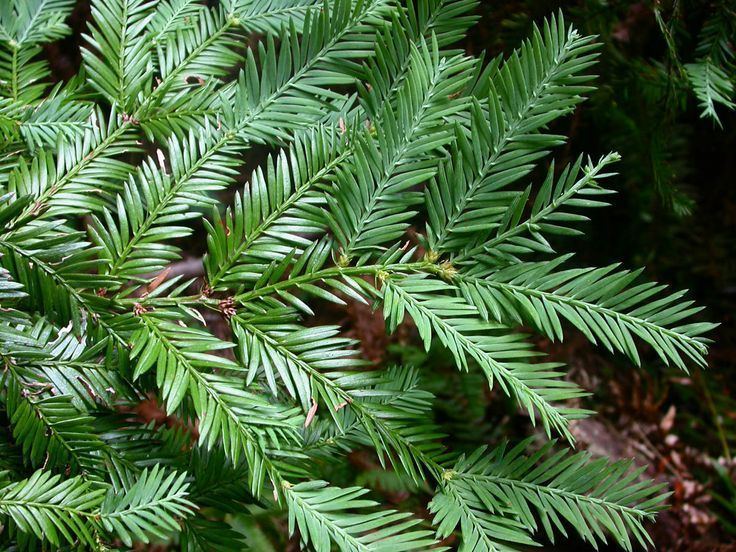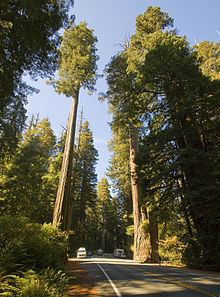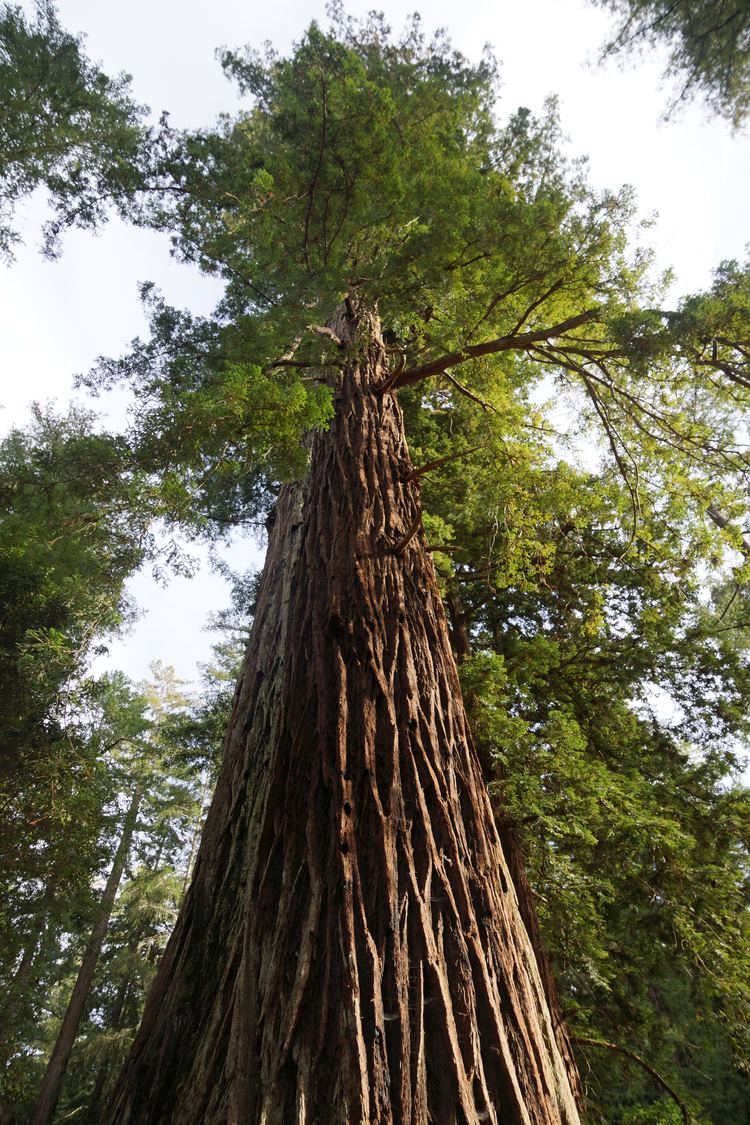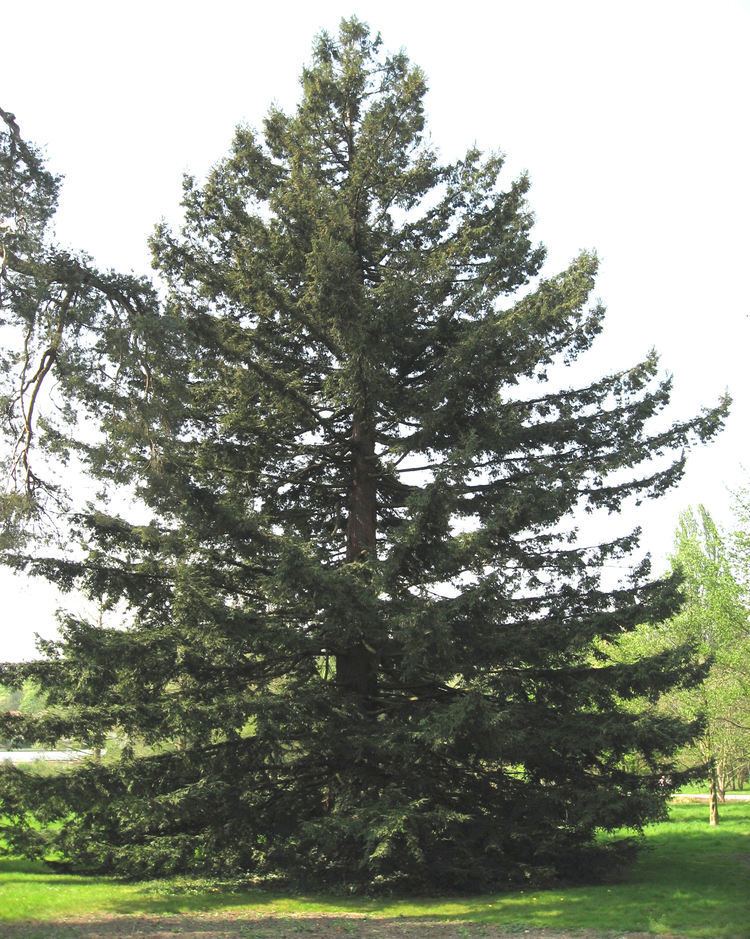Rank Species Symbol of California | Division Pinophyta Higher classification Sequoia | |
 | ||
Conservation status Endangered (Population decreasing) Similar Giant sequoia, Redwoods, Pine, Metasequoia glyptostroboides, Conifers | ||
Sequoia sempervirens coastal redwood inventory plant oregon
Sequoia sempervirens /sᵻˈkɔɪ.ə sɛmpərˈvaɪrənz/ is the sole living species of the genus Sequoia in the cypress family Cupressaceae (formerly treated in Taxodiaceae). Common names include coast redwood, coastal redwood and California redwood. It is an evergreen, long-lived, monoecious tree living 1,200–1,800 years or more. This species includes the tallest living trees on Earth, reaching up to 379 feet (115.5 m) in height (without the roots) and up to 29.2 feet (8.9 m) in diameter at breast height (dbh). These trees are also among the oldest living things on Earth. Before commercial logging and clearing began by the 1850s, this massive tree occurred naturally in an estimated 2,100,000 acres (8,500 km2) along much of coastal California (excluding southern California where rainfall is not sufficient) and the southwestern corner of coastal Oregon within the United States.
Contents
- Sequoia sempervirens coastal redwood inventory plant oregon
- Plant id giant redwood sequoia sempervirens
- Taxonomy
- Description
- Distribution and habitat
- Ecology
- Reproduction
- Cultivation and uses
- Statistics
- Largest trees
- Tallest trees
- Other notable examples
- References

The name sequoia sometimes refers to the subfamily Sequoioideae, which includes S. sempervirens along with Sequoiadendron (giant sequoia) and Metasequoia (dawn redwood). Here, the term redwood on its own refers to the species covered in this article, and not to the other two species.

Plant id giant redwood sequoia sempervirens
Taxonomy

Scottish botanist David Don described the redwood as the evergreen taxodium (Taxodium sempervirens) in his colleague Aylmer Bourke Lambert's 1824 work A description of the genus Pinus. Austrian botanist Stephan Endlicher erected the genus Sequoia in his 1847 work Synopsis coniferarum, giving the redwood its current binomial name of Sequoia sempervirens. The redwood is one of three living species, each in its own genus, in the subfamily Sequoioideae. Molecular studies have shown the three to be each other's closest relatives, generally with the redwood and giant sequoia (Sequoiadendron giganteum) as each other's closest relatives. However, Yang and colleagues in 2010 queried the polyploid state of the redwood and speculate that it may have arisen as an ancient hybrid between ancestors of the giant sequoia and dawn redwood (Metasequoia). Using two different single copy nuclear genes, LFY and NLY, to generate phylogenetic trees, they found that Sequoia was clustered with Metasequoia in the tree generated using the LFY gene, but with Sequoiadendron in the tree generated with the NLY gene. Further analysis strongly supported the hypothesis that Sequoia was the result of a hybridization event involving Metasequoia and Sequoiadendron. Thus, Yang and colleagues hypothesize that the inconsistent relationships among Metasequoia, Sequoia, and Sequoiadendron could be a sign of reticulate evolution (in which two species hybridize and give rise to a third) among the three genera. However, the long evolutionary history of the three genera (the earliest fossil remains being from the Jurassic) make resolving the specifics of when and how Sequoia originated once and for all a difficult matter—especially since it in part depends on an incomplete fossil record.
Description

The coast redwood can reach 115 m (377 ft) tall with a trunk diameter of 9 m (30 ft). It has a conical crown, with horizontal to slightly drooping branches. The bark can be very thick, up to 1-foot (30 cm), and quite soft and fibrous, with a bright red-brown color when freshly exposed (hence the name redwood), weathering darker. The root system is composed of shallow, wide-spreading lateral roots.

The leaves are variable, being 15–25 mm (0.59–0.98 in) long and flat on young trees and shaded shoots in the lower crown of old trees. On the other hand, they are scale-like, 5–10 mm (0.20–0.39 in) long on shoots in full sun in the upper crown of older trees, with a full range of transition between the two extremes. They are dark green above and have two blue-white stomatal bands below. Leaf arrangement is spiral, but the larger shade leaves are twisted at the base to lie in a flat plane for maximum light capture.

The species is monoecious, with pollen and seed cones on the same plant. The seed cones are ovoid, 15–32 millimetres (0.59–1.26 in) long, with 15–25 spirally arranged scales; pollination is in late winter with maturation about 8–9 months after. Each cone scale bears three to seven seeds, each seed 3–4 millimetres (0.12–0.16 in) long and 0.5 millimetres (0.020 in) broad, with two wings 1 millimetre (0.039 in) wide. The seeds are released when the cone scales dry out and open at maturity. The pollen cones are ovular and 4–6 millimetres (0.16–0.24 in) long.

Its genetic makeup is unusual among conifers, being a hexaploid (6n) and possibly allopolyploid (AAAABB). Both the mitochondrial and chloroplast genomes of the redwood are paternally inherited.
Distribution and habitat
Coast redwoods occupy a narrow strip of land approximately 750 km (470 mi) in length and 5–47 mi (8.0–75.6 km) in width along the Pacific coast of North America; the most southerly grove is in Monterey County, California, and the most northerly groves are in extreme southwestern Oregon. The prevailing elevation range is 98–2,460 ft (30–750 m) above sea level, occasionally down to 0 and up to 3,000 ft (about 920 m). They usually grow in the mountains where precipitation from the incoming moisture off the ocean is greater. The tallest and oldest trees are found in deep valleys and gullies, where year-round streams can flow, and fog drip is regular. The trees above the fog layer, above about 2,296 ft (700 m), are shorter and smaller due to the drier, windier, and colder conditions. In addition, Douglas fir, pine, and tanoak often crowd out redwoods at these elevations. Few redwoods grow close to the ocean, due to intense salt spray, sand, and wind. Coalescence of coastal fog accounts for a considerable part of the trees' water needs.
The northern boundary of its range is marked by groves on the Chetco River on the western fringe of the Klamath Mountains, near the California-Oregon border. The largest (and tallest) populations are in Redwood National and State Parks (Del Norte and Humboldt Counties) and Humboldt Redwoods State Park (Humboldt County, California), with the majority located in the much larger Humboldt County. The southern boundary of its range is the Los Padres National Forest's Silver Peak Wilderness in the Santa Lucia Mountains of the Big Sur area of Monterey County, California. The southernmost grove is in the Southern Redwood Botanical Area, just north of the national forest's Salmon Creek trailhead. The southernmost grove can be seen from California Highway 1 at the approximate coordinates 35°49'42 N 121°23'14 W.
The prehistoric fossil range of the genus is considerably greater, with a subcosmopolitan distribution including Europe and Asia until about 5 million years ago. During the last ice age, perhaps as recently as 10,000 years ago, redwood trees grew as far south as the Los Angeles area (coast redwood bark found in subway excavations and at La Brea tar pits).
Ecology
This native area provides a unique environment with heavy seasonal rains up to 100 inches (2,500 mm) annually. Cool coastal air and fog drip keep this forest consistently damp year round. Several factors, including the heavy rainfall, create a soil with fewer nutrients than the trees need, causing them to depend heavily on the entire biotic community of the forest, especially complete recycling of the trees when dead. This forest community includes coast Douglas fir, Pacific madrone, tanoak, western hemlock, and other trees, along with a wide variety of ferns, mosses, mushrooms, and redwood sorrel. Redwood forests provide habitat for a variety of amphibians, bird, mammals, and reptiles. Old-growth redwood stands provide habitat for the federally threatened spotted owl and the California-endangered marbled murrelet.
The thick, tannin-rich bark, combined with foliage starting high above the ground, provides good protection from both fire and insect damage, contributing to the coast redwood's longevity. The oldest known specimen is about 2,200 years old; many others in the wild exceed 600 years. The numerous claims of older trees are incorrect. Because of their seemingly timeless lifespans, coast redwoods were deemed the "everlasting redwood" at the turn of the century; in Latin, sempervirens means "ever green" or "everlasting". Redwood must endure fire to attain such great ages, so this species has many fire-resistant characteristics. In addition, fires appear to actually benefit redwoods by causing substantial mortality in competing species while having only minor effects on redwood. A study published in 2010, the first to compare postwildfire survival and regeneration of redwood and associated species, concluded fires of all severity increase the relative abundance of redwood and higher-severity fires provide the greatest benefit.
The height of S. sempervirens is closely tied to fog availability; taller trees become less frequent as fog becomes less frequent. As S. sempervirens’ height increases, transporting water via water potential to the leaves becomes increasingly more difficult due to gravity. Despite the high rainfall that the region receives (up to 100 cm), the leaves in the upper canopy are stressed for water. The water stress is believed to cause the morphological changes in the leaves, stimulating reduced leaf length and increased leaf succulence. Water stress is reduced in the upper canopy by the leaves taking in fog from the surrounding air through the epidermal tissue, bypassing the xylem. The uptake of water through the leaves causes the xylem flow to reverse, which repairs and reduces the severity of cavitations.
Reproduction
Coast redwood reproduces both sexually by seed and asexually by sprouting of buds, layering, or lignotubers. Seed production begins at 10–15 years of age, and large seed crops occur frequently, but viability of the seed is low, typically well below 15%. The low viability may discourage seed predators, which do not want to waste time sorting chaff (empty seeds) from edible seeds. The winged seeds are small and light, weighing 3.3–5.0 mg (200–300 seeds/g; 5,600–8,500/ounce). The wings are not effective for wide dispersal, and seeds are dispersed by wind an average of only 60–120 m (200–390 ft) from the parent tree. Growth of seedlings is very fast, with young trees known to reach 20 m (66 ft) tall in 20 years.
Coast redwoods can also reproduce asexually by layering or sprouting from the root crown, stump, or even fallen branches; if a tree falls over, it will regenerate a row of new trees along the trunk, so many trees naturally grow in a straight line. Sprouts originate from dormant or adventitious buds at or under the surface of the bark. The dormant sprouts are stimulated when the main adult stem gets damaged or starts to die. Many sprouts spontaneously erupt and develop around the circumference of the tree trunk. Within a short period after sprouting, each sprout will develop its own root system, with the dominant sprouts forming a ring of trees around the parent root crown or stump. This ring of trees is called a "fairy ring". Sprouts can achieve heights of 2.3 m (7.5 ft) in a single growing season.
Redwoods may also reproduce using burls. A burl is a woody lignotuber that commonly appears on a redwood tree below the soil line, though usually within 3 metres (10 ft) in depth from the soil surface. Burls are capable of sprouting into new trees when detached from the parent tree, though exactly how this happens is yet to be studied. Shoot clones commonly sprout from burls and are often turned into decorative hedges when found in suburbia.
The species is very tolerant of flooding and flood deposits, the roots rapidly growing into thick silt deposits after floods.
Cultivation and uses
Coast redwood is one of the most valuable timber species in the lumbering industry. In California, 899,000 acres (3,640 km2) of redwood forest are logged, virtually all of it second growth. Though many entities have existed in the cutting and management of redwoods, perhaps none has had a more storied role than the Pacific Lumber Company (1863–2008) of Humboldt County, California, where it owned and managed over 200,000 acres (810 km2) of forests, primarily redwood. Coast redwood lumber is highly valued for its beauty, light weight, and resistance to decay. Its lack of resin makes it resistant to fire.
P.H. Shaughnessy, Chief Engineer of the San Francisco Fire Department wrote,
"In the recent great fire of San Francisco, that began April 18th, 1906, we succeeded in finally stopping it in nearly all directions where the unburned buildings were almost entirely of frame construction, and if the exterior finish of these buildings had not been of redwood lumber, I am satisfied that the area of the burned district would have been greatly extended."Because of its impressive resistance to decay, redwood was extensively used for railroad ties and trestles throughout California. Many of the old ties have been recycled for use in gardens as borders, steps, house beams, etc. Redwood burls are used in the production of table tops, veneers, and turned goods.
The coast redwood is naturalized in New Zealand, notably at Whakarewarewa Forest, Rotorua. Redwood has been grown in New Zealand plantations for over 100 years, and those planted in New Zealand have higher growth rates than those in California, mainly due to even rainfall distribution through the year. Other areas of successful cultivation outside of the native range include Great Britain, Italy, Portugal, Haida Gwaii, middle elevations of Hawaii, Hogsback in South Africa, a small area in central Mexico (Jilotepec), and the southeastern United States from eastern Texas to Maryland. It also does well in the Pacific Northwest (Oregon, Washington, and British Columbia), far north of its northernmost native range in southwestern Oregon. Coast redwood trees were used in a display at Rockefeller Center and then given to Longhouse Reserve in East Hampton, Long Island, New York, and these have now been living there for over twenty years and have survived at 2 °F (−17 °C).
This fast-growing tree can be grown as an ornamental specimen in those large parks and gardens that can accommodate its massive size. It has gained the Royal Horticultural Society's Award of Garden Merit.
Statistics
Trees over 200 feet (60 m) are common, and many are over 300 ft (90 m). The current tallest tree is the Hyperion tree, measuring 379.3 ft (115.61 m). The tree was discovered in Redwood National Park during the summer of 2006 by Chris Atkins and Michael Taylor, and is thought to be the world's tallest living organism. The previous record holder was the Stratosphere Giant in Humboldt Redwoods State Park at 370.2 ft (112.84 m) (as measured in 2004). Until it fell in March 1991, the "Dyerville Giant" was the record holder. It, too, stood in Humboldt Redwoods State Park and was 372 ft (113.4 m) high and estimated to be 1,600 years old. This huge fallen giant has been preserved in the park to allow visitors to walk the trail along its trunk.
Forty-one measured living trees are more than 360 ft (109.7 m) tall, and 178 are more than 350 ft (106.7 m) tall. Preliminary LiDAR data indicate hundreds of additional trees are in excess of 350 ft (106.7 m), which were previously unknown. It is interesting to note that, as of 2016, no living specimen of other tree species exceeds 100 m (328.1 ft). A tree claimed to be 380 ft (115.8 m) was cut down in 1914, and another claimed to be 424 ft (129.2 m) was felled in November 1886 by the Elk River Mill and Lumber Co. in Humboldt County, yielding 79,736 marketable board feet from 21 cuts. However, these accounts and many others must be viewed with skepticism as limited evidence corroborates the measurements, and exaggerated claims were not uncommon in the lumber industry.
Although coast redwoods are the tallest known living trees, historical accounts of taller Australian mountain ash and Douglas fir trees exist – sometimes exceeding 400 ft (122 m). Like most of the redwoods, these giants fell victim to widespread commercial logging in the 19th and 20th centuries and the tallest existing specimens of each are much shorter than the tallest redwoods. A Douglas fir that fell in 1924 in Mineral, Washington was determined to have been about 1020 years old, 393 ft (119.8 m) high, and 15.4 ft (4.69 m) in diameter by two highly respected forest scientists. Another Douglas fir cut down in 1902 at Lynn Valley on the north shore of the city of Vancouver, British Columbia was reported to have measured 415 ft (126.5 m) in height and 14.3 ft (4.36 m) in diameter, although these measurements are somewhat less certain. Other accounts claim felled Douglas firs were as tall as 465 feet (141.7 m).
These accounts aside, fairly solid evidence indicates that coast redwoods were the world's largest trees before logging, with numerous historical specimens reportedly over 400 ft (122 m). The theoretical maximum potential height of coast redwoods is thought to be limited to between 400 and 425 ft (121.9 and 129.5 m), as evapotranspiration is insufficient to transport water to leaves beyond this range. Further studies have indicated this cap is eased by fog, which is prevalent in these trees' natural environment.
The largest known living coast redwood used to be "Iluvatar", with an estimated single trunk volume of 37,500 cu ft (1,060 m3), but more giant redwoods were discovered in 2014, including Grogan's Fault, with 38,299 cu ft (1,084.5 m3). Lost Monarch has been reported as the largest in the past, but its main trunk is 36,500 cu ft (1,030 m3).
About 230 albino redwoods (mutant individuals that cannot manufacture chlorophyll) are known to exist, reaching heights of up to 20 m (66 ft). These trees survive as parasites, obtaining food by grafting their root systems with those of normal trees. While similar mutations occur sporadically in other conifers, no cases are known of such individuals surviving to maturity in any other conifer species.. Recent research news reports that albino redwoods can store higher concentrations of toxic metals, going so far as comparing them to organs or "waste dumps". Some obvious speculation in the news reports has been expertly countered.
Largest trees
Some volumes are based on additional stems. Extra stems can have a point of origin above ground from the main trunk, or be basal and emerge separately from soil level. For Lost Monarch, some writers included 6,000 ft3 worth of large basal sprouts, referred to by Dr. Robert Van Pelt as "separate trees". The largest single coast redwood tree published is "Grogan's Fault". More were found, but remain undisclosed. One apparently surpasses General Sherman's (Giant Sequoia) 1321 American Forest big tree registry champion points by 40 points or more. These are 12 of the largest coast redwoods by total wood volume in the main trunk, or trunk and stems combined, as of 2009 - 2016:. In 2014, a new trend emerged where new redwood discovery photos are not all being released.
Note: Bole volume in this context is the volume of the main trunk plus any reiterated trunks.
Diameter stated is as measured at 1.4 m (about 4.5 ft) above average ground level (diameter at breast height). Details of the precise locations of all above trees have not been announced to the general public for fear of publicity causing damage to the trees and the surrounding ecology. The order of largest and tallest can change at any time due to new discoveries, loss of stem and foliage, growth, and new measurements. One of the better known internet databases for large conifers is the Gymnosperm Database, but its data can be different from other resources due to differences in standards.
Tallest trees
Tallest redwoods may be measured every year, but newest data is published without identifying what measurement goes with what name. The specific names of tallest trees may remain unknown indefinitely after 2010. It has been revealed that Redwood National Park does not hold all three of the tallest trees. Specific locations and definite knowledge is kept confidentially among a handful of professional tree researchers and discoverers. The list below is based on conifers.org maintained by Dr. Chris Earl, and may be the last bona fide update by a verifiable expert where both names and heights were listed together.
Diameter stated is as measured at 1.4 m (about 4.5 ft) above average ground level (at breast height). Details of the precise locations for most tallest trees were not announced to the general public for fear of causing damage to the trees and the surrounding ecology. The tallest coast redwood easily accessible to the public is the Founders Tree in Humboldt Redwoods State Park, standing over 346 ft tall. A taller coast redwood is also accessible to the public in Tall Trees Grove of Redwood National Park.
